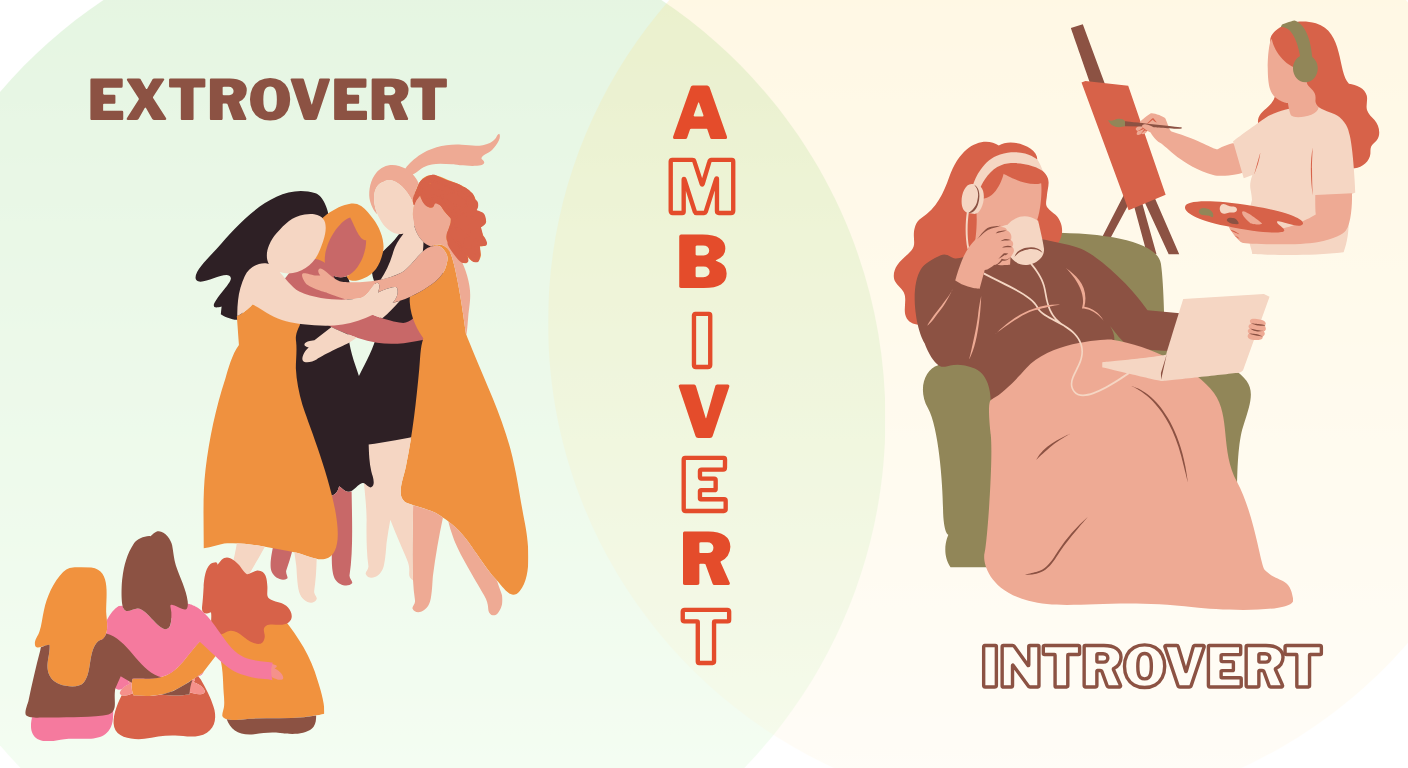What Is an Ambivert? The Balanced Personality Explained
Denise Murphy Editor / Nov 7, 2025
With the rising popularity of the MBTI personality test, most people are familiar with the terms of extrovert and introvert. But have you ever felt like you don’t fully fit into either category? That you love being around people sometimes, while other times you prefer staying alone? If that sounds familiar, you might be an ambivert.

What Is an Ambivert
The Cambridge Dictionary defines an ambivert as someone who exhibits both introverted and extroverted traits depending on the situation. Unlike people who are strictly introverted or extroverted, ambiverts can switch between these two behaviors. This flexibility allows ambiverts to adapt to various environments and social contexts easily.
Here's a quick comparison between introverts, ambiverts, and extroverts. If you’re curious about your personality type, check this out.
| Introvert | Ambivert | Extrovert | |
| Recharge Mode | Spending time alone | Both alone and with others | Being around people |
| Social Preference | Small groups or one-on-one | Comfortable in both small and large settings | Prefers lively, social environments |
| Communication | Thoughtful and reserved | Flexible — quiet or talkative depending on context | Outgoing and expressive |
| Work Style | Likes working independently | Adaptable to working alone or in teams | Enjoys teamwork and collaboration |
| Key Traits | Quiet, reflective | Balanced, adaptable | Outgoing, enthusiastic |
5 Signs You Might Be an Ambivert
1. Social Interactions Can Be Both Draining and Refreshing
When you’re hanging out with your friends, you might get energy and become expressive in the whole social setting. That is because you’re with the right people in the right place. But throw you into a boring meeting with strangers? You might feel cringy and end up making an escape plan in a corner. This is one of the clearest signs that you might be an ambivert.
2. Performing Well on Your Own and in Groups
Individual tasks come easily to you because you can stay focused and productive when working alone. But you aren’t afraid of group projects either cause you know how to collaborate, contribute, and even compromise when needed. Whether it’s individual work or group work, you can handle it confidently.
3. Enjoying the Spotlight Occasionally
Although most of the time you may prefer to stand behind others and be a good listener, being in the spotlight occasionally can actually be enjoyable. For example, giving a presentation on something you’re good at might boost your confidence. However, it can still stress you out if it lasts a long time.
4. Making Friends Is Not That Tough
Compared to introverts, you may find making friends easier. Sometimes, you are the one who reaches out and starts conversations with others. But you’re not as outgoing as extroverts, who can talk to just about anyone they meet.
You probably find that while you enjoy meeting new people, you still share interesting things and meaningful moments with just a few close friends. That’s what differentiates ambiverts from both extroverts and introverts.
5. Alone Time Is Essential for Recharging
Whether it is after a joyful gathering with friends or a formal event, a quiet, comfortable place where no one will disturb you is what you need after a long time socializing. No matter whether you’re zoning out or just scrolling through your phone, being alone is essential for you to recharge.

Strengths of Being an Ambivert
You may have realized the strengths of being an ambivert. By blending the qualities of both introverts and extroverts, ambiverts possess strengths that allow them to navigate social and professional situations with ease.
Strong Relationships
Ambiverts excel at building strong and meaningful relationships because they naturally balance listening and sharing. On the one hand, they can be attentive listener when facing extroverts, providing casual but necessary responses. On the other hand, they can connect deeply with introverts by sharing sincere feelings and creating genuine bonds.
Balanced Decision-Making
Due to their flexible thinking, ambiverts tend to make well-rounded decisions. They consider each option carefully and are willing to compromise when it benefits the bigger picture. In social outings, they tend to make balanced decisions to avoid conflicts and maintain a sense of peace.
Empathy Energy
Ambiverts often have a high level of empathy because they understand the need for social connection and the value of introspection. They put themselves in others’ shoes and recognize emotional changes quickly. As a result, they often take care of the ignored ones and offer support to those in need, making them compassionate friends.
Challenges Ambiverts Face
Ambiverts’ fluctuating energy can be confusing and bring downsides. People might expect them to act consistently extroverted or introverted, and often don’t understand the sudden energy shifts. Meanwhile, ambiverts themselves may feel equally puzzled when they go from being a social butterfly to hiding in their room dodging texts, sometimes just faster than a microwave beeps. This shift can cause ambiverts to burn out faster than those who lean toward one side.
Empathy can be a double-edged sword since ambiverts often find themselves playing a mediator role in a group setting. This type of emotional work can be draining and often goes unnoticed.

Tips to Thrive as an Ambivert
With a better grasp of ambiverts’ characteristics, here are some practical strategies to help ambiverts thrive:
Set Boundaries
Just because you can blend into different situations doesn’t mean you always should. Learn to say ”no” when needed, even if it goes against your natural tendency to keep the peace.
Plan Ahead
Stay ahead of burnout. If you know that socializing is likely to drain you, then schedule in some alone time. Don’t feel guilty about making your recharge time one of the top priorities.
Communicate Your Needs
Let others know when you’re in a different mode. It’s okay not to be “on“ all the time. Open communication helps others know your energy shifts without misunderstanding.
Career Paths for Ambiverts
Considering the balance of ambiverts’ personalities, roles that are hybrid, people-oriented, or independent with meaningful interactions tend to allow ambiverts to perform well. These roles allow ambiverts to switch between social engagement and focused solo work, depending on their energy and needs.
People + Task Hybrid Roles
Popular options: UX/UI Designer, Product Manager, Psychologist
These careers require both individual work with analytical thinking and interpersonal communication, allowing ambiverts to flex both sides of their personality.
People-Oriented Roles
Popular options: Teacher, Salesperson
These positions require strong interpersonal connections but often follow predictable routines, giving ambiverts the chance to recover and reset between social demands.
Independent Roles with Some Interaction
Popular options: Freelance Writer, Research Analyst
These roles allow ambiverts to control when and how they engage with others. These paths provide flexibility, but still offer meaningful collaboration when needed, which prevents both isolation and burnout.
Final Thoughts
Ambiverts combine the qualities of both extroverts and introverts, balancing the need for social connection with the need for alone time. This flexibility is a strength, but managing these contrasting needs can cause confusion and burnout if not handled well. Understanding their strengths and limitations helps ambiverts embrace themselves and navigate life with greater ease.
Disclaimer
Any assessments and their associated content on this website, regardless of date, are not intended to replace direct medical advice from your physician or other professional. If you experience severe or persistent symptoms, please consult a licensed mental health professional or healthcare provider.







